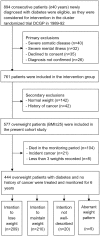Intentional Weight Loss and Longevity in Overweight Patients with Type 2 Diabetes: A Population-Based Cohort Study
- PMID: 26808532
- PMCID: PMC4726824
- DOI: 10.1371/journal.pone.0146889
Intentional Weight Loss and Longevity in Overweight Patients with Type 2 Diabetes: A Population-Based Cohort Study
Abstract
Objective: This study examined the influence of weight loss on long-term morbidity and mortality in overweight (BMI≥25 kg/m2) patients with type 2 diabetes, and tested the hypothesis that therapeutic intentional weight loss supervised by a medical doctor prolongs life and reduces the risk for cardiovascular disease in these patients.
Methods: This is a 19 year cohort study of patients in the intervention arm of the randomized clinical trial Diabetes Care in General Practice. Weight and prospective intentions for weight loss were monitored every third month for six years in 761 consecutive patients (≥40 years) newly diagnosed with diabetes in general practices throughout Denmark in 1989-92. Multivariable Cox regression was used to estimate the association between weight change during the monitoring period (year 0 to 6) and the outcomes during the succeeding 13 years (year 6 to 19) in 444 patients who were overweight at diagnosis and alive at the end of the monitoring period (year 6). The analysis was adjusted for age, sex, education, BMI at diagnosis, change in smoking, change in physical activity, change in medication, and the Charlson comorbidity 6-year score. Outcomes were from national registers.
Results: Overall, weight loss regardless of intention was an independent risk factor for increased all-cause mortality (P<0.01). The adjusted hazard ratio for all-cause mortality, cardiovascular mortality, and cardiovascular morbidity attributable to an intentional weight loss of 1 kg/year was 1.20 (95%CI 0.97-1.50, P = 0.10), 1.26 (0.93-1.72, P = 0.14), and 1.06 (0.79-1.42, P = 0.71), respectively. Limiting the analysis to include only those patients who survived the first 2 years after the monitoring period did not substantially change these estimates. A non-linear spline estimate indicated a V-like association between weight change and all-cause mortality, suggesting the best prognosis for those who maintained their weight.
Conclusions: In this population-based cohort of overweight patients with type 2 diabetes, successful therapeutic intentional weight loss, supervised by a doctor over six years, was not associated with reduced all-cause mortality or cardiovascular morbidity/mortality during the succeeding 13 years.
Conflict of interest statement
Figures




Similar articles
-
Weight Changes in General Practice.Dan Med J. 2017 Jun;64(6):B5376. Dan Med J. 2017. PMID: 28566125
-
Prospective study of intentional weight loss and mortality in overweight white men aged 40-64 years.Am J Epidemiol. 1999 Mar 15;149(6):491-503. doi: 10.1093/oxfordjournals.aje.a009843. Am J Epidemiol. 1999. PMID: 10084238
-
Prospective study of intentional weight loss and mortality in never-smoking overweight US white women aged 40-64 years.Am J Epidemiol. 1995 Jun 15;141(12):1128-41. doi: 10.1093/oxfordjournals.aje.a117386. Am J Epidemiol. 1995. PMID: 7771451
-
A review and meta-analysis of the effect of weight loss on all-cause mortality risk.Nutr Res Rev. 2009 Jun;22(1):93-108. doi: 10.1017/S0954422409990035. Nutr Res Rev. 2009. PMID: 19555520 Review.
-
Intentional weight loss: patterns in the general population and its association with morbidity and mortality.Int J Obes Relat Metab Disord. 1997 Mar;21 Suppl 1:S14-9; discussion S20-1. Int J Obes Relat Metab Disord. 1997. PMID: 9130036 Review.
Cited by
-
Type 2 Diabetes Incidence and Mortality: Associations with Physical Activity, Fitness, Weight Loss, and Weight Cycling.Rev Cardiovasc Med. 2022 Oct 25;23(11):364. doi: 10.31083/j.rcm2311364. eCollection 2022 Nov. Rev Cardiovasc Med. 2022. PMID: 39076198 Free PMC article. Review.
-
Weight change and mortality and cardiovascular outcomes in patients with new-onset diabetes mellitus: a nationwide cohort study.Cardiovasc Diabetol. 2019 Mar 19;18(1):36. doi: 10.1186/s12933-019-0838-9. Cardiovasc Diabetol. 2019. PMID: 30890169 Free PMC article.
-
Body weight changes in patients with type 2 diabetes and a recent acute coronary syndrome: an analysis from the EXAMINE trial.Cardiovasc Diabetol. 2021 Sep 14;20(1):187. doi: 10.1186/s12933-021-01382-8. Cardiovasc Diabetol. 2021. PMID: 34521390 Free PMC article.
-
Moderate weight change following diabetes diagnosis and 10 year incidence of cardiovascular disease and mortality.Diabetologia. 2019 Aug;62(8):1391-1402. doi: 10.1007/s00125-019-4886-1. Epub 2019 May 7. Diabetologia. 2019. PMID: 31062041 Free PMC article.
-
Intentional Weight Loss, Waist Circumference Reduction, and Mortality Risk Among Postmenopausal Women.JAMA Netw Open. 2025 Mar 3;8(3):e250609. doi: 10.1001/jamanetworkopen.2025.0609. JAMA Netw Open. 2025. PMID: 40048162 Free PMC article.
References
-
- Maggio CA, Pi-Sunyer FX (1997) The prevention and treatment of obesity. Application to type 2 diabetes. Diabetes Care 20: 1744–1766 - PubMed
-
- Uusitupa M, Peltonen M, Lindstrom J, Aunola S, Ilanne-Parikka P, Keinänen-Kiukaanniemi S, et al. (2009) Ten-year mortality and cardiovascular morbidity in the Finnish Diabetes Prevention Study—Secondary analysis of the randomized trial. PLoS One 4: e5656 10.1371/journal.pone.0005656 - DOI - PMC - PubMed
Publication types
MeSH terms
LinkOut - more resources
Full Text Sources
Other Literature Sources
Medical

